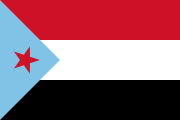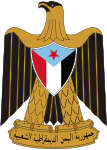People's Democratic Republic of Yemen
| جمهورية اليمن الديمقراطية الشعبية | |||||
|
Jumhūrīyat al-Yaman al-Dīmuqrātīya al-Shabīya |
|||||
| People's Democratic Republic of Yemen | |||||
| 1967-1990 | |||||
|
|||||
| Official language | Arabic | ||||
| Capital | Aden | ||||
| Form of government | People's Republic | ||||
| Government system | socialist one-party system | ||||
| surface | 332,970 km² | ||||
| population | 2,100,000 (1982) | ||||
| currency | South Yemeni dinar | ||||
| independence | 1967 | ||||
| resolution | 1990 | ||||
| Time zone | UTC + 3 | ||||
| Telephone code | +969 | ||||
People's Democratic Republic of Yemen ( Arabic جمهورية اليمن الديمقراطية الشعبية Jumhūrīyat al-Yaman ad-Dīmuqrātīya asch-Schaʿbīya , DMG Ǧumhūrīyat al-Yaman ad-Dīmuqrāṭīya aš-Šaʿbīya , in the parlance of the GDR People's Democratic Republic of Yemen ) was the name of a state in South Yemen that existed from 1967 to 1990 since 1970. Before that, the state was called the People's Republic of South Yemen . The capital was Aden .
history
South Yemen (so the common name) became independent from British colonial rule, which had existed since the 1830s, on November 30, 1967, after the South Arab Federation and the Protectorate of South Arabia had merged to form the People's Republic of Yemen (officially: People's Republic of South Yemen ). Three years later a new constitution was passed (1970) and it was renamed to the term "Democratic People's Republic of Yemen" (DVRJ or DVJ), which was used until 1990. Scientific socialism was enshrined in the constitution as a political credo , which was intended to express that all Yemeni interests were anticipated.
Domestic politics
The People's Democratic Republic of Yemen pursued a socialist policy under a Marxist unity party , the Yemeni Socialist Party , and was closely aligned with the socialist Eastern Bloc . Large businesses and large parts of real estate were nationalized. As early as 1978, head of state Salim Rubai Ali lost his life in internal power struggles; in 1986, conflicts over the political opening of the country broke out into a two-week civil war with thousands of dead within the Unity Party, in which the head of state Ali Nasir Muhammad al-Hassani (1980-1986 ) was overthrown. However, his supporter Haidar Abu Bakr al-Attas was able to assert himself as head of state.
The emancipation of women was expressly promoted in domestic politics . As a result of the rapprochement with the Soviet Union and partly also with the People's Republic of China (for example, the Soviet Union used the territory of South Yemen for logistical purposes of its own foreign policy , for example to support the revolutionary regime in Ethiopia ), there was, in return, an increasing displacement of Islam from the Everyday life. The ideological basis and the real politics of South Yemen thus differed from the non-aligned states of Egypt and Libya , which propagated an Arab socialism .
Foreign policy
With the Yemeni Arab Republic and Saudi Arabia , which existed in North Yemen, there were repeated armed conflicts due to border disputes and the support of opposition groups in the other country, but also repeatedly to reconciliation agreements and unification plans (1972, 1979). June 1978 turned out to be particularly difficult when the President of North Yemen, Colonel Ahmad Husayn Al-Ghashmi, was killed by a letter bomb allegedly originating in South Yemen and only two days later the South Yemeni President Salim Ruba'i fell victim to a fatal coup 1979 led to the second border war. This could only be pacified through the Kuwait treaties in March of the same year following international pressure .
There were also conflicts with Oman when the People's Republic supported a socialist guerrilla movement in the Dhofar War. This war ended in 1975. Peace agreements were signed with Saudi Arabia and later Kuwait in 1976, after which the country received, among other things, Saudi economic aid.
The government received support from the German Democratic Republic in the 1980s, but South Yemen sealed itself off from Western countries. In February 1975, German members of the Red Army faction were flown to South Yemen by free pressing and in May 1978 by a prisoner exchange .
With the collapse of the Eastern Bloc in 1989, there was a political and economic rapprochement with the Yemeni Arab Republic , which ultimately resulted in the reunification of the two parts of the country on May 22, 1990.
Democratic Republic of Yemen
After reunification with the Yemeni Arab Republic , another attempt to split off from al-Attas failed four years later (May 21 to July 7, 1994). This short-lived Democratic Republic of Yemen , which adopted the old state symbols (coat of arms and flag), was diplomatically recognized only by Oman and unofficially by the other states of the Gulf Cooperation Council.
Political system
Heads of state
List of heads of state of the (Democratic) People's Republic of Yemen:
- Qahtan Muhammad al-Sha'bi (November 30, 1967 to June 22, 1969)
- Salim Rubai Ali (June 23, 1969 to June 26, 1978)
- Ali Nasir Muhammad (July 1, 1978 to December 27, 1978)
- Abd al-Fattah Ismail (December 27, 1978 to April 21, 1980)
- Ali Nasir Muhammad (April 21, 1980 to January 24, 1986)
- Haidar Abu Bakr al-Attas (January 24, 1986 to May 22, 1990)
Administrative division
The People's Democratic Republic of Yemen was divided into six governorates that still exist in Yemen today.
| number | Surname | Area (in km²) | Capital |
|---|---|---|---|
| I. | Adan | 6,980 | Aden |
| II | Lahij | 12,766 | Hawatah |
| III | Abyan | 21,489 | Zindschibar |
| IV | Shabwah | 73.908 | ʿAtaq |
| V | Hadhramawt | 155,376 | al-Mukalla |
| VI | al-Mahra | 66,350 | al-Ghaida |
See also
literature
- Tareq Y. Ismael, Jacqueline S. Ismael: The People's Democratic Republic of Yemen: Politics, Economics, and Society; The Politics of Socialist Transformation . Lynne Rienner Pub. 1986, ISBN 0-931477-96-4 .
- Noel Brehony: Yemen Divided. The Story of a Failed State in South Arabia. IB Tauris, London / New York 2011, ISBN 978-1-84885-635-6 .
Individual evidence
- ↑ Horst Kopp, Länderkunde Yemen , 2005, p. 159.
- ↑ Ursula Braun, North and South Yemen in the field of tension between internal, regional contrasts , Bonn 1981, p. 1.
- ↑ Magdi El-Menshaui, Alois Meyer, Thomas Kozinowski, On the political and economic situation of Yemen , 1980, p. 153.
- ↑ Ueli Brunner, Yemen. From frankincense to petroleum , 1999, p. 11.
- ^ Thomas Cieslik, Reunions during and after the East-West bloc confrontation. Causes of the division - Basics of the (missing) unity , Marburg 2001, p. 1119.



